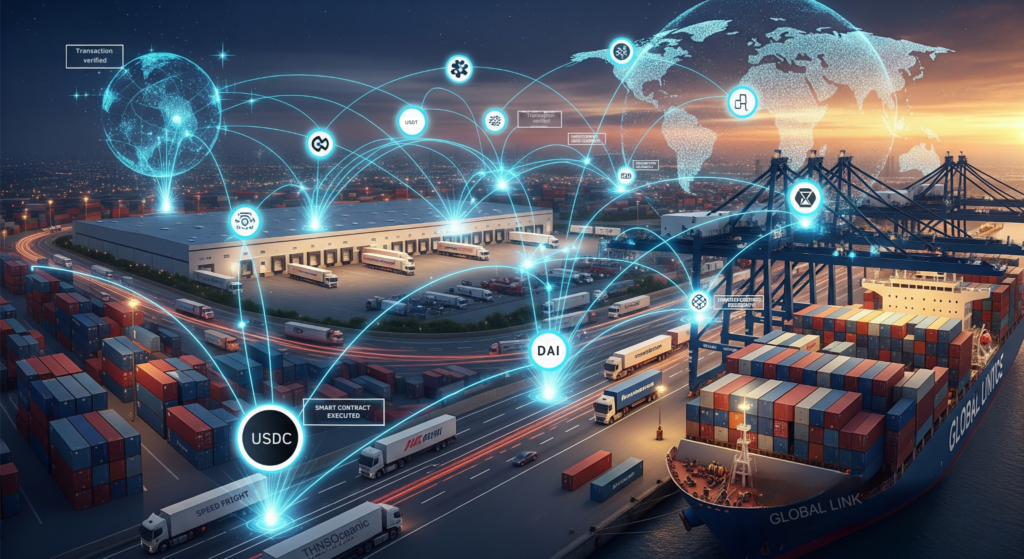In today’s hyper-connected global economy, the movement of physical goods has accelerated dramatically. Yet, the financial systems underpinning this trade remain mired in the past. For Chief Financial Officers and treasury leaders, the process of making cross-border B2B payments is a persistent source of friction, cost, and risk. While domestic payments have seen significant innovation, international transactions are notoriously slow, opaque, and expensive, acting as a strategic drag on growth and efficiency. However, a powerful convergence of blockchain technology and enterprise-grade stablecoins is now creating a new paradigm: the programmable supply chain, where payments are as fast, transparent, and automated as the data that drives modern logistics.
The High Cost of Waiting: Quantifying the Friction in Global Payments
The inefficiencies of traditional supply chain finance are not merely operational annoyances; they represent tangible costs that erode margins and strain partner relationships. Even without hitting bottlenecks, an average cross-border payment can take three to five business days to settle, a delay that ties up critical working capital for suppliers and creates uncertainty for buyers. This friction can be deconstructed into four primary challenges, as identified by global financial bodies like the G20.
Cost: A Death by a Thousand Cuts
The final amount received in a cross-border transaction is often significantly less than the amount sent. This is due to a layered system of fees, many of which are hidden. Payments travel through a network of intermediary correspondent banks, each charging for their service. Added to this are foreign exchange (FX) markups embedded in unfavorable rates, card network assessment fees for international transactions, and the significant overhead of maintaining compliance with varying regulations. This lack of cost transparency makes financial forecasting a constant challenge.
Speed: The Settlement Lag
The multi-day settlement time is a direct consequence of the siloed, manual processes inherent in the correspondent banking system. Time zone differences, multiple institutional handoffs, and independent compliance checks (such as Anti-Money Laundering and Know Your Customer screenings) at each step create cumulative delays. For suppliers, especially small and medium-sized enterprises (SMEs), this lag can severely disrupt cash flow and inhibit their ability to participate in global trade.
Transparency: The Payment Black Box
A major complaint from finance teams is the profound lack of visibility into a payment’s journey. Once a transaction enters the SWIFT system, it often disappears into a “black box,” with no real-time tracking available. This uncertainty complicates accounting reconciliation, damages supplier trust when funds are delayed, and makes it difficult to resolve issues when they arise.
Fraud: The Imposter Vendor Threat
A critical vulnerability in supply chain payments is fraud conducted through the SWIFT system. In this common scenario, fraudsters pose as genuine vendors, using compromised emails or forged documents to trick an organization into paying large sums into a fraudulent account. Once the payment is sent, the system’s inherent delays make it nearly impossible to stop the transaction before the imposters disappear with the funds, resulting in direct financial loss and damaged supplier relationships.
Access and Compliance: A Fragmented Landscape
The global financial system is not a monolith. Access to reliable banking infrastructure varies significantly by region, and the number of banks providing correspondent services has been declining, further limiting access to certain markets. Compounding this is a complex and often conflicting web of international regulations (AML, KYC, GDPR), which creates operational friction and exposes businesses to significant financial and reputational risk for non-compliance. This system inherently disadvantages businesses in emerging markets, creating a financial barrier that stifles global economic inclusion.

The Architectural Shift: Building the Rails for Programmable Payments
To overcome these foundational challenges, a complete architectural shift is necessary. This is where blockchain technology, or DLT, provides the solution. By establishing a shared and immutable ledger, blockchain creates unprecedented transparency for all parties in a transaction. It replaces the opaque nature of legacy systems with a single source of truth, directly mitigating risks like payment delays and fraud in cross-border payments.
The true innovation, however, lies in making these secure transactions programmable. Through the use of smart contracts, self-executing agreements with terms written directly into code, programmable payments become a reality. Imagine a scenario where a payment to an international supplier is automatically executed the moment goods are verified at a port. This level of automation transforms supply chain finance from a series of manual, friction-filled steps into a fluid, efficient, and data-driven workflow.
This blockchain-based architecture effectively builds the new rails for a more resilient and efficient future of global trade finance. It provides the trust, transparency, and automation that businesses demand. But these advanced rails require an equally advanced asset to move across them.
“The critical next question for treasury leaders is: what form of digital currency offers the stability required for enterprise-scale programmable payments?”
The Catalyst for Commerce: Stablecoins as Enterprise-Grade Digital Dollars
While blockchain provides the rails for this new system, a stable, trusted medium of exchange is needed to run on them. Volatile cryptocurrencies like Bitcoin are unsuitable for corporate treasury. The solution is stablecoins. Digital assets specifically designed to maintain a stable value by being pegged to a real-world asset, most commonly the U.S. dollar.
For enterprise use, fiat-backed stablecoins are the gold standard. Issuers like Circle (USDC) and Tether (USDT) back each digital token 1:1 with reserves of cash and short-term government securities held at regulated financial institutions. This model, supported by regular third-party audits and increasing regulatory clarity, provides the stability and trust required for B2B payments.
The stablecoin market is rapidly maturing from a niche experiment into a core component of future payment infrastructure. With a circulating supply already over $150 billion and projected to approach $2 trillion by 2028, as per a recent projection highlighted in an article from McKinsey, its role is being validated by financial giants like Visa, Mastercard, and PayPal, who are actively integrating them. This “tokenization of cash” creates a global, 24/7 programmable payment layer, forcing incumbent institutions to adapt or risk disintermediation in key payment corridors.
From Theory to Treasury: High-Value Use Cases
The combination of blockchain and stablecoins unlocks immediate, high-value applications that directly address the pain points of supply chain finance.
- Instant Cross-Border Supplier Payments: A U.S.-based manufacturer can pay a supplier in Asia using USDC. The transaction settles in minutes for a fee of less than a dollar, compared to days and significant fees for a traditional wire transfer. The supplier receives the funds almost instantly in a digital wallet and can convert them to their local currency through a partner exchange. This dramatically improves supplier cash flow and strengthens relationships. Companies like Acctual are already powering millions in low-cost USDC invoices across more than 100 countries.
- Automated Invoice Financing: A supplier can tokenize an approved invoice on a blockchain. This digital asset can then be used as collateral for a loan or sold on a decentralized marketplace to a global pool of investors, who provide immediate liquidity in stablecoins. The entire process, from financing to repayment, can be automated with smart contracts, creating a more efficient and competitive market for working capital finance.
The Pragmatist’s Guide to Implementation and the Path Forward
Despite the clear advantages, enterprise adoption faces hurdles. The regulatory landscape, while maturing, remains complex. However, the most significant barrier is technical: integrating this new world of blockchain and digital wallets with the legacy Enterprise Resource Planning (ERP) and treasury systems that run global businesses. ERPs from vendors like SAP were not built for blockchain, and bridging this gap can require significant investment in specialized talent and custom development.
This “build vs. buy” dilemma is where Blockchain-as-a-Service (BaaS) platforms become a strategic accelerator. Instead of building a complex and expensive blockchain infrastructure from scratch, enterprises can leverage a BaaS provider to abstract away the complexity. This approach drastically reduces development timelines from months or years to mere weeks, lowers costs, and enables existing Web 2.0 developers to build powerful blockchain applications using familiar tools like REST APIs.
The transition to a programmable, efficient, and secure global payment system is happening now. The strategic advantage will belong to those who act decisively. While the challenges of implementation may seem daunting, the path forward is clear. To unlock the future of supply chain finance, businesses need a partner that can bridge the gap between legacy systems and the new financial internet.
Explore the FLEXBLOK platform to discover how our enterprise-grade Blockchain-as-a-Service solution can empower your organization to make secure and smooth stablecoin transactions a reality. Our platform is built on an interoperable, Ethereum-based architecture that complies with enterprise standards, offering a rich suite of APIs, including our Token API and Transaction API, that eliminate technical hurdles. Schedule a demo with our experts to design your blockchain roadmap and transform your supply chain payments from a cost center into a competitive advantage.


